Delicate Taste of Tongli - The Most Famous Garden, Returning to Siyuan
Travel time: March 2021
Walking mode: self driving
Travel route:
D1:
Nanjing - Suzhou Tongli Ancient Town (Tuisiyuan - Lize Girls' School - Wang Shaoao Memorial Hall - Pearl Tower - Chuanxin Lane)
D2:
Suzhou Tongli Ancient Town (Jiayin Hall Chongben Hall Gengle Hall Luo Xingzhou) - Tongli Beilian Village - Suzhou Luzhi (Baosheng Temple - Shen Baihan's Former Residence - Rice Shop - Jiangnan Cultural Park) - Nanjing
I used my weekends to visit the ancient town of Suzhou and chose Tongli, which I had never been to before. It's a pity to say that I only came to see Tongli in Nanjing for decades, but it also indicates that there are too many good places in Jiangnan, and it takes years to see them all. The road conditions are good, and I followed the navigation smoothly to the north parking lot in Tongli. After stopping the car and contacting the inn, I found out that our inn was located to the south of the ancient town. I thought it wouldn't be too far to walk there, so I could take a closer look at the ancient town. Tickets purchased at the tourist center cost 80 yuan per person. Tourists only need to buy tickets to enter the ancient town, and there are several scenic spots in the town that require ticket verification to enter. A ticket purchase is valid for two days, which is convenient for tourists like us who choose to stay in the inn.
After purchasing the tickets, we entered the ancient town and a lively atmosphere rushed in, with crowds of people on the streets. On one side of the street is the babbling water, and on the other side is the dazzling variety of Tongli specialties in the shops along the street. Stepping on a cobblestone road, accompanied by a small river, crossing a small bridge, all the way south. Due to the large number of tourists and our luggage, we didn't stop to enjoy and headed straight to the inn on Zhuxing Street, our destination. After checking in, I brought my camera and couldn't wait to leave.
As soon as Zhuxing Street comes out, it is this unique Tailai Bridge. The bridge body is already tall, and with a large bamboo pavilion built on the top of the bridge, it appears even more majestic and majestic.

A few steps away from the Tailai Bridge is a three arch stone bridge - the Zhongchuan Bridge.

Zhongchuan Bridge is a bridge connecting Zhongchuan Road in Tongli Town to the ancient town. The memorial archway in the south of the bridge is the sign of the ancient town. You need a ticket to enter the memorial archway.

Standing on the towering Tai Lai Bridge, looking at Tongli Water Town, an ancient town with a long history and typical water town style.

Pink walls and black tiles, water, sound, and air all blend with an ancient charm.

The clear river water reflects the entire Tailai Bridge
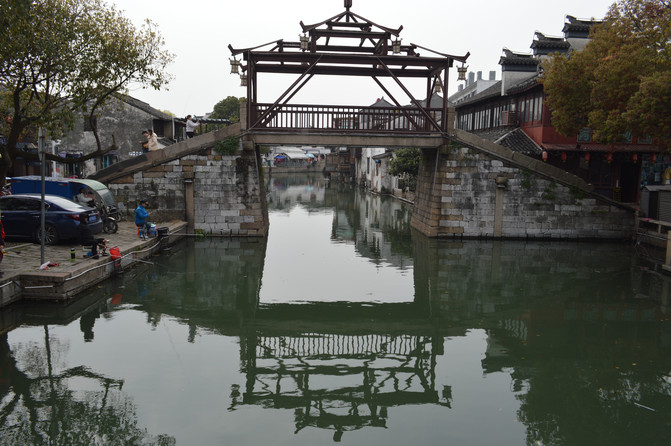
On both sides of the river, many residential buildings with pink walls and black tiles are from the Ming and Qing dynasties, arranged in rows. There are many preserved ancient buildings in the ancient town, making it one of the most well preserved water towns in Jiangsu Province.

Due to the water forming the town, every household is connected to the water, and every household has access to boats, creating a beautiful picture of a water town with a staggered layout.

A peach tree full of pink peach blossoms illuminated the mottled pink walls and tiles.

Most of the houses on both sides of the Taiwan Strait have now become inns or bars, giving these ancient buildings new vitality.

Passing by the Ming and Qing commercial streets, there was no rush to enter, just a faint drift.

Continue north along Zhongchuan Road

There is an open square,

There is an ancient stage at one end of the square.

Due to its typical beauty as an ancient town in Jiangnan, Tongli has attracted numerous filming teams to come here to shoot film and television dramas. Therefore, a "China Tongli Film and Television Photography Base" has been established here. The floor tiles of the square are engraved with the signatures of various filming teams.

We didn't wander around randomly, but used the attractions included in the ticket as our guide to start our journey in Tongli. The first stop was a high walled garden next to the square - Tuisiyuan.
Address: 234 Xinfill Street, Tongli Town, Wujiang District, Suzhou City
A small facade on the tall white courtyard wall, so inconspicuous, made me wonder. There are several identity cards hanging by the door. The first one on the left is the time when the garden was completed - the Qing Dynasty. The second plaque on the left is a UNESCO World Heritage Site plaque that was awarded by the United Nations Educational, Scientific and Cultural Organization in November 2000. The second on the right introduces the former site of the Lize Girls' School, while the first on the right uses simple text to introduce the campus. From these simple plaques, it can be inferred that the Guisi Garden, built between the 11th and 13th years of the Guangxu reign of the Qing Dynasty (1885-1887 AD), was the residence of the owner Ren Lansheng who was accused of returning to his hometown to "retreat and hear thoughts". It is also a world cultural heritage site.

Go through the aisle between the foyer and the tea hall. The Tui Si Yuan residential area is divided into two parts: internal and external. The outer house has three entrances - the foyer, tea hall, and main hall, arranged along the axis, with clear levels. Outer houses are mainly used for receiving guests, wedding ceremonies, and ancestor worship ceremonies.

The tea hall, also known as the flower hall, is used to receive ordinary guests.

The courtyard between the tea hall and the main hall

Exquisite flower windows

The main hall, also known as the "Yin Yu Hall", is used to receive noble guests, organize ancestor worship ceremonies, weddings, and funerals.


Small Scenery in the Garden

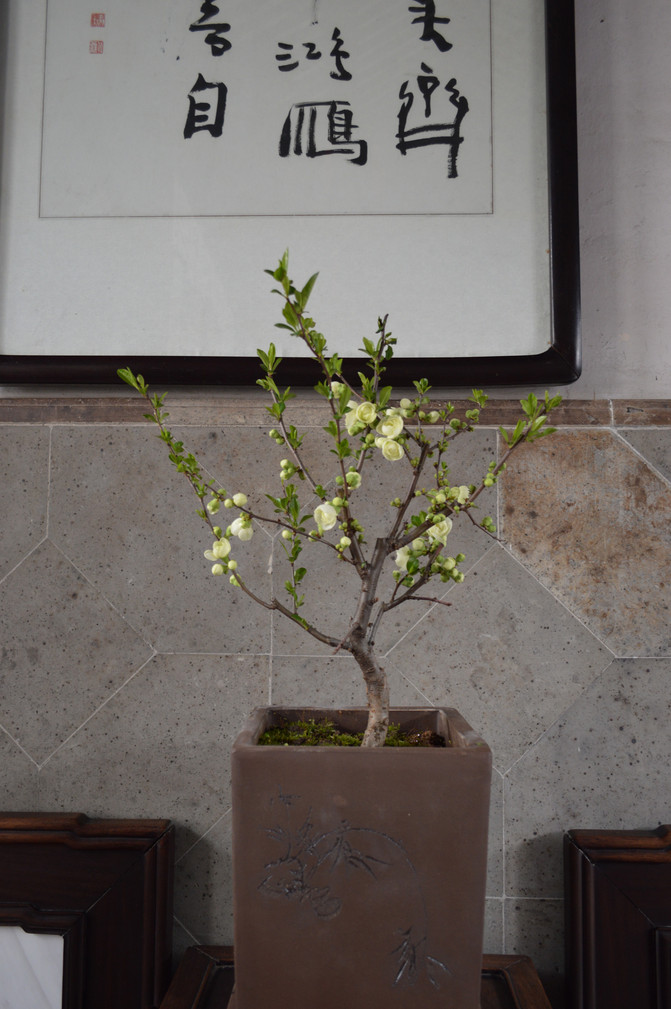
The inner and outer houses can be separated and combined, with a compact layout. The east wall of the outer house is separated by the inner house of the retreat garden.

The two running horse towers with five floors and five floors in the north and south, named "Wanduo Tower" in Japanese, are the living places for the garden owner and their families. The black pillars and red columns of the Paoma Tower hang down, and the buildings are connected by double corridors. A ladder is set up under the corridor, which not only provides shelter from wind and rain, but also separates the master and servant.

The bottom floor of "Wanxiang Tower" features an introduction to the history and culture of the Ren family and the Tui Si Garden.



There is also an interactive area with a Go table. It's such an elegant thing to have someone leisurely and elegant set up a game here!

There is also a Paper Cuttings shop in the racetrack - "Cutting Nanchun". The owner is Ji Jianming, the first shear in Jiangnan, a native of his hometown.

Heading east from the Paoma Tower, you enter a larger courtyard, which is also the courtyard of the Tui Si Garden. The atrium serves as the end of the residence and also serves as a transition from the residence to the garden. A ship shaped building with a head and no tail docked in the courtyard is called a dry boat, which is introduced as used for guests to park and disembark from their sedans. In front of the ship, there is a scenery composed of rockeries, small trees, and exotic flowers and plants. On both sides of the dry boat are the bedrooms of male and female guests sitting in the Spring Moon Tower, and the tea room of the winter scenery "Pine, Bamboo, and Plum", which confirms the thoughtful and enthusiastic hospitality of the garden owner.

There are two tall magnolias on both sides of the ship, one white magnolia and one broad magnolia. Two tall magnolia trees covered the entire hull of the ship under the shade of green, and everywhere outside the window was green and lush.
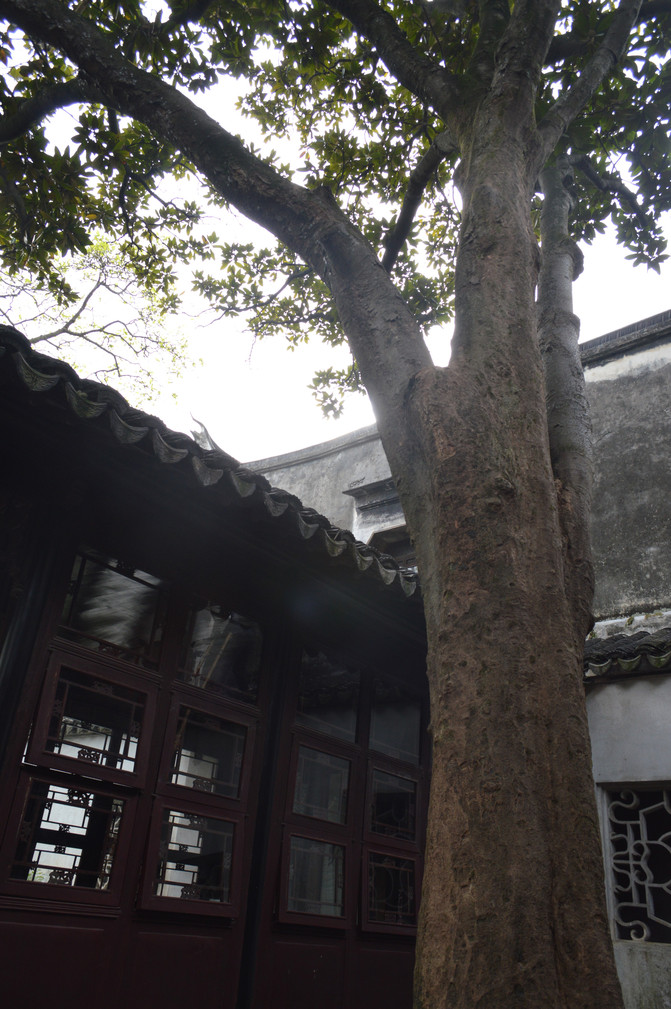
The three windows above the mottled walls on one side of the Moon Tower, three types of window flowers, lush old trees, and green moss under the walls are all traces of history.

Planting camphor and magnolia in front of the court, it is strong and ancient. The small courtyard does not use much pen and ink, but it is fascinating and naturally connected, playing a great role in laying the foundation for the garden.
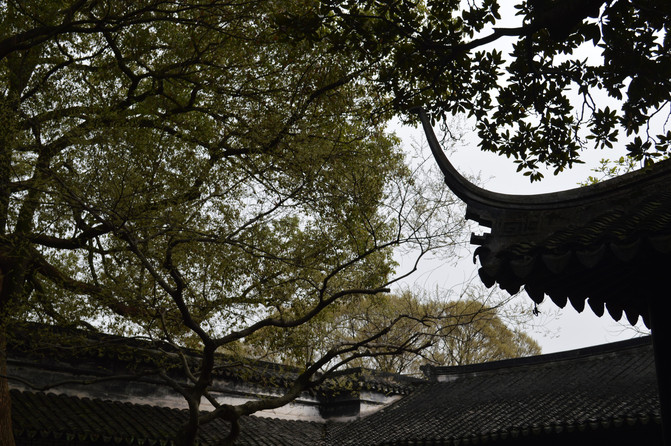
The bow of the boat faces east, straight towards the "Cloud Smoke Lock Key" lunar cave gate, like a waiting boat, guiding visitors towards the eastern garden. This is the true essence of the landscape of Tui Si Yuan.

The round door that passes through the courtyard is the garden, and the entrance to the garden is closely adjacent to the tall pink wall of the atrium, which is the Water Champs. The waterside pavilion is located in the ound ridge roof of the Xieshan Mountain. It overhangs the water surface and is opposite to the Tuisi Thatched Cottage across the water. The three sides of the waterfront are surrounded by beautiful seats, which are now used by tourists to enjoy the scenery.

View the garden of Tui Si Yuan on the water pavilion. The garden is centered around water, with buildings and rockeries arranged along the water's edge. The buildings are mostly built close to the water, highlighting the vastness of the water surface. Therefore, Tuisiyuan is also known as the "Water Garden". Facing each other across the water, the center on the north bank of the small pond is the core of Dongyuan - Tuisi Caotang. The grass hall is five rooms wide, with ound ridge roof on the hill and corridors on all sides. It is simple and elegant. The white stone platform in front of the hall is stretched and lightweight, extending into the water surface, steady and atmospheric.
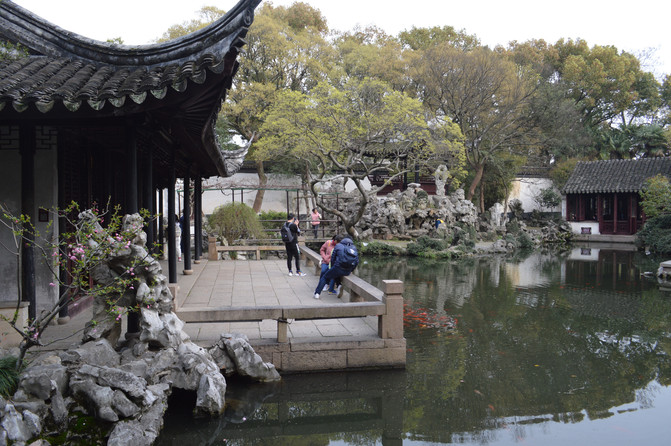
The Water Champagne Pavilion runs along the left side, forming a winding corridor with historical inscriptions on its walls.

From the corridor towards the pool water, the water quality is clear, and all the scenery is mirrored, creating a unique artistic conception.

Moving a few steps, there are one or two irregular pentagonal towers, which are called Range Rover Pavilion, also known as Miss Tower. The Range Rover Pavilion is closely located outside the east mountain wall of the main building of the courtyard, Sitting on the Spring Moon Tower. It has three sides and six windows, with two floors above and below, which is unique in shape and ingenious, allowing female guests to enjoy the scenery of the park without leaving their homes.

The furnishings in the bay below the Range Rover Pavilion are quaint and elegant.

The landscape in front of the Range Rover Tower is centered on a pool of clear water, with ripples and shadows. Small and delicate buildings scattered around the pool water. On the left is a thatched cottage, on the right is a water pavilion, and in the distance in the middle is a bustling red boat.

Take a few more steps to reach the main architectural feature of the garden, the Tuisi Thatched Cottage. The Tuisi Thatched Cottage, located in the northern court, is simple and elegant, without seeking grandeur. Whether it is door and window decoration or furniture display, this idea is reflected everywhere.

The terrace south of the thatched cottage faces the pool water, and standing on the terrace provides a panoramic view of the entire garden. On the right front is a bustling red vessel, on the back two floors is Xintai, and on the left side by the water is Ziyu Shengliang Pavilion. In the small space, the designer cleverly combined the land and air in the architectural space of the Jiangnan water town by combining pavilions, terraces, towers, pavilions, corridors, squares, bridges, pavilions, halls, halls, houses, and pavilions with a pool as the center, making it a unique example of Jiangnan.

Looking at the Water Champs and Range Rover Pavilion from a different perspective, coupled with the rockeries, flowers, plants, and trees in the foreground, it is like a serene landscape painting.

The boat shaped building facing southeast on the opposite side - Naohong Yige. The bow of the ship adopts a suspended mountain form, and the roof opening is slightly lower; The hull of the ship is supported by lake rocks, as if sailing through rivers and seas. The tail of the boat takes root by the pond, accompanied by tall trees. Behind the bustling red vessel is the "Nine Curved Corridor" built around the water. The corridor twists and turns, with ups and downs in height, and nine windows of different shapes are embedded on the wall.
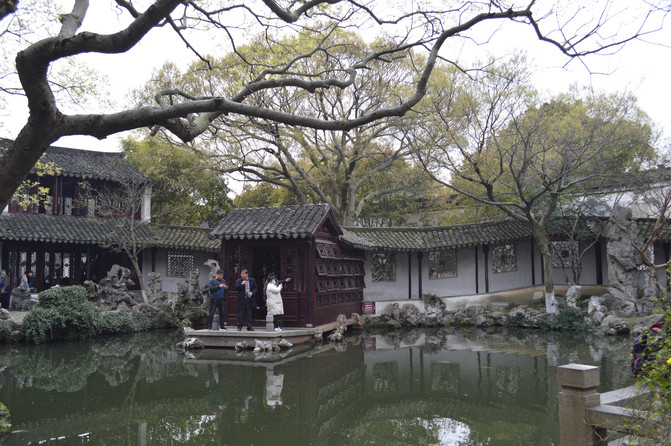
The Tuisi Caotang is the main scenery of the entire park, standing on the platform in front of the hall and looking around, providing a 360 ° panoramic appreciation.

Leaving the thatched cottage, continue to rotate clockwise along the pond. After a bamboo bridge, there is a rockery, a sleeping cloud pavilion on the mountain, and after the rockery, there is the Ziyu Shengliang Pavilion.

Looking into the garden with a broad field of vision, the water and buildings are closely intertwined, and the entire garden seems to float on the water because the agility of the water adds a sense of dynamism to the entire garden.

The water is clear, like a mirror reflecting everything around us, creating a round and full picture.

The design of the pavilion, which is built with water, is unique. There are three original water channels at the bottom of the pavilion, which serve as natural air conditioning. The interior of the pavilion is damp and cool. In the middle of the pavilion, there is a grand view, and in front of the mirror, there is a fragrant concubine's bed. With the addition of floor to ceiling window frames, during the scorching summer heat, even without leaving the pavilion, one can enjoy the beautiful scenery of mountains and rivers from the mirror. Here, one can escape the heat and enjoy the cool, dissecting melons and admiring lotus flowers, which is a favorite place for women.

Looking from the window of the Ziyu Shengliang Pavilion towards the garden, the layout is compact and natural, combined with plant arrangements, with ups and downs, creating a seamless and seamless atmosphere. Just like a piece of music that perfectly combines human and nature, with a prelude and a climax.

Arriving in front of the bustling red vessel, one can closely observe its exquisite craftsmanship. The deep red hanging lattice windows on both sides, with half open designs adorned with window flowers, resemble the scales on a fish's body. Enlarge your gaze, the bustling red boat echoes with the surrounding lake stones and the grassy cottage across the pond, achieving a harmonious unity between the environment and nature.

Walk around the pond along the winding corridor, enjoying the ever-changing scenery and poetic and picturesque atmosphere. On the corridor, you can see half of the pavilion, which leads to the Osmanthus Hall.

It is named after the bushes of osmanthus planted throughout the garden. In the golden autumn season, when the fragrance of osmanthus fills the garden, sweetness must enter the heart. The road surface paved with small pebbles in the courtyard is full of artistic changes.

The Osmanthus Hall, with five bays, was originally a family temple and a library.

The Hongyi Pavilion here now displays the calligraphy and paintings of painter Zhou Jianhong.

This is the exit of Tui Si Yuan, with a slightly larger facade than the import, but it is still low-key.

In fact, besides taking a look at the self driving route and booking an inn, I didn't do any more homework when I came to Tongli. So returning to Siyuan is to find the nearest attraction to the inn according to the attractions included in the ticket and start walking. Entering the Tuisiyuan from the simple and narrow entrance under the pink wall, I was still thinking about how the "World Cultural Heritage" plaque at the entrance came about. After passing through the dark sedan hall, the place where one's gaze went was completely different from the initial feeling. One entry is more beautiful than the other, and one scenery is more unique than the other. The Tui Si Garden is small and exquisite, light and elegant, with pavilions and terraces covering it. It is full of fun, and the architecture in the garden is overwhelming, yet it unfolds a three-dimensional picture for us with a certain degree of relaxation. Take a walk around, I understand
Why did Tui Si Yuan receive the title of World Cultural Heritage.
